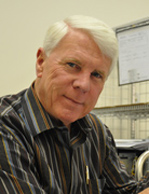Helping doctors find the right diagnosisPowerful Patient, 2010 Week 3bHost: Joyce Graff, http://powerfulpatient.org, editor@vhl.org 800-767-4845
Getting to the right diagnosis is not an easy process. There are thousands of diseases to choose from - too much for any human being to hold in his or her head. Support is being sought from computers, but computers are only as smart and the people whose knowledge is captured in the programming. Jim Hitchin from SpectraScience shares with Joyce the benefits that his WavSTATR Optical Biopsy System and LUMAR Cervical Imaging Systems are bringing to the doctor's arsenal of tools to determine whether tissues are normal, pre-cancerous, or cancerous.
About our guest:
Jim Hitchin, CEO, joined the Company in March 2004 as part of the acquisition team. Previously he was the founder, CEO and Chairman of Infrasonics, Inc., a medical device company in the respiratory care field. The company was the first in its market to have ISO9001 and the CE Mark for fourteen 510(k) and two PMA products. Growth was at a compound rate of 62% during its fifteen-year life before being sold to a competitor. In previous companies, he was COO of a public energy company and the VP, General Manager of a public oceanographic engineering firm. Mr. Hitchin has extensive experience in all phases of manufacturing and company operations. He graduated from San Diego State University with a B.S. degree in Physics
About Optical Biopsy
The optical biopsy machine is a light probe similar to the device used for endoscopy. The difference is that when anything suspicious is seen in the lininc of the colon, or on the cervix or other tissues being explored the physician can touch the tissue and the software in the machine evaluates the tissue, giving a green light (normal) or a red light (needs follow-up). The physician can then snip a specimen of the suspect tissue to send to the lab.
With current endoscopy protocols, numerous samples are taken of all tissues, a large number of which will be normal. This device saves the patient from having samples taken of normal tissue, which reduces the number of wounds and the risk of infection. It also provides more rapid feedback to the physician and the patient - instead of waiting days or weeks for the results from the pathology lab, patients with normal readings will know that by the end of the procedure. Samples taken from suspect tissues will still need to go to pathology for confirmation, but the process is streamlined considerably.
This technology is alre
ady in use in Europe to evaluate suspected colon cancer, Crohn's disease, ulcerative colitis, and cervical cancer. U.S. approval is pending at this time. It is being used experimentally at the Mayo Clinic (Minnesota), UCAL (California), and the Veterans' Administration hospitals in Kansas City and Boston. SpectraScience is currently working on calibrating the system for exploration of the esophagus, and hopes in future to develop software for use in evaluating the lung.
This is only one of the many ways that computer science and data can be used to benefit patients. Some applications have already emerged, and many more are in preparation. As the United States moves toward electronic health records, we will see an increasing number of ways that computers can assist doctors - never replace them! But assist them in analyzing an ever-increasing amount of data, and sorting through it all to arrive at a list of suggested diagnoses to be validated or ruled out in the clinic.
For more information about SpectraScience, see <http://www.spectrascience.com>http://www.spectrascience.com |
